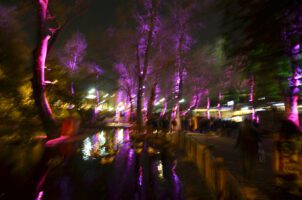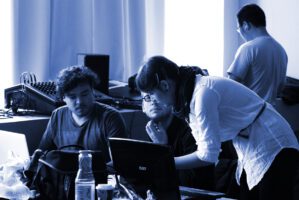28 / Axel Buether: Building culture is …
Human cultural evolution begins with the discovery of ways to sustainably adapt the natural environment to our own needs. Humans are thus seizing the opportunity, previously only seized by a single species, to innovatively, systematically and productively transform all areas and functions of life. The oldest traces of man’s enormously productive engagement with the spatiality of his existence in the environment, which continues to this day, can be found in the Japanese Chichibu. Stone tools were found not far from Tokyo together with the 500,000-year-old textile remains of mobile dwellings of the nomadic Homo Erectus life form. As technological extensions of our bodily functions, tools not only make our existence in the natural world easier, they also open up completely new scope for shaping our environment. As a result, the planning and designing trade becomes a driving force for social development.
Even the first human structures had to meet the technological requirements of hunter-gatherers in terms of mobility, modularity and durability. In addition to the material achievements, the immaterial achievements of Baukultur are also gaining in importance, as they are increasingly becoming a regulatory instrument and set of rules for shaping society. An increasingly complex system of external and internal spaces enables our species to hierarchize and specify the ways in which we live together. Building culture thus becomes a shaper and reflection of society.
Building culture as a vivid memory of mankind
The human genome differs from that of the chimpanzee by only one percent, a difference to our closest biological relative, which has evolved over a period of more than six million years. The main driving force behind the development of our way of life is the cultural formation of individuals, which has been taking place for around 6,500 years through written language, for around 40,000 years through pictorial works and sculptures, for around 100,000 years through spoken language and for around 500,000 years through building culture and everyday objects.
Even if these figures should be used with caution due to the constant stream of new discoveries, the value of our species’ architectural culture’s engagement with the way we are in the environment becomes clear here. The creative and culture-forming dialogue between the organization of life and the shaping of the environment that is carried out in this way fertilizes the intergenerational learning process of individuals and steers the development of societies. Cultural evolution expands the capacity of our genome, as the cultural space increasingly becomes a vivid repository of human knowledge, the contents of which each generation has to acquire anew.
Transformations of our buildings and settlement areas drive cultural development and thus take on the function of biological mutations. Changes in social requirements cause the disappearance of building forms, while new structural ideas for the organization and representation of society must first prove themselves in use. Building culture and society function according to the principle of co-evolution or mutual adaptation, as planners not only anticipate the needs of their contemporaries in the design process, but are also constantly looking for new ways of organizing life. What drives them to do so is irrelevant from a cultural evolutionary point of view, as the search for greater functionality can contribute just as much to the further development of society as the testing of visionary utopias.
Baukultur fertilizes the discourse on the meaning and purpose of our existence
In the lifelong learning process of the brain, the individual develops a vivid model of their own world, which forms the basis of all perception, thought and action processes. Even language only gains meaning where words refer to vividly imaginable facts. Who are we? Where do we come from and where are we going? What connects us and what divides us? What is beauty and what is ugliness? What do we dream of and how do we want to live in the future? It is the questions about the meaning and purpose of our existence that we ask ourselves again and again in our confrontation with the architectural evidence of the living environment that we ourselves have created.
An individual’s perception of the environment and imagination are just as varied and extensive as the quality and quantity of the questions generated solely by the attentive and curious gaze. Building culture demands that we touch and explore the environment designed according to our needs through our gaze, which only tells us as much as we have already experienced through the interaction of all our senses in the process of exploring the environment. In the process of visual perception of the built environment, we trace the design of ordering mechanisms and functional principles with the searching movements of our eyes, linking significant parts to form a meaningful whole.
The coherence of the parts of a building with each other and with the whole serves to make its function legible, as it not only conveys to us its purpose of existence, but also clear instructions for its use. The atmospheric effect of the situation, on the other hand, is reflected in the viewer’s perceptual experience, his thoughts and emotions. By examining the external and internal nature of the structural matrix of our existence, we learn a lot about ourselves, can trace our origins, understand our present and dream our future.
The cross-generational cultivation of a creative discourse on the meaning and purpose of our existence takes place in a material and immaterial way both through building and through the intellectual reflection of what has been built. The Latin term “cultura” refers to the amount and quality of care that we invest in maintaining and renewing our living environment. Building culture involves not only the care of the material substance, but also the cultivation of discourse on all the important questions of our existence.
Link Homepage of the Federal Foundation of Baukultur



